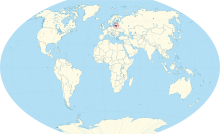
A | B | C | D | E | F | G | H | CH | I | J | K | L | M | N | O | P | Q | R | S | T | U | V | W | X | Y | Z | 0 | 1 | 2 | 3 | 4 | 5 | 6 | 7 | 8 | 9
Republic of Lithuania Lietuvos Respublika (Lithuanian) | |
|---|---|
| Anthem: Tautiška giesmė "National Hymn" | |
Location of Lithuania (dark green) – in Europe (green & dark grey) | |
| Capital and largest city | Vilnius 54°41′N 25°19′E / 54.683°N 25.317°E |
| Official languages | Lithuanian[1] |
| Ethnic groups (2024[2]) |
|
| Religion (2021[3]) |
|
| Demonym(s) | Lithuanian |
| Government | Unitary semi-presidential republic[4][5][6][7] |
| Gitanas Nausėda | |
| Ingrida Šimonytė | |
| Viktorija Čmilytė-Nielsen | |
| Legislature | Seimas |
| Formation | |
| 9 March 1009 | |
| 1236 | |
• Coronation of Mindaugas | 6 July 1253 |
| 2 February 1386 | |
• Commonwealth created | 1 July 1569 |
| 24 October 1795 | |
| 16 February 1918 | |
| 11 March 1990 | |
• Joined the European Union | 1 May 2004 |
| Area | |
• Total | 65,300 km2 (25,200 sq mi) (121st) |
• Water (%) | 1.98 (2015)[8] |
| Population | |
• 2024 estimate | |
• Density | 44/km2 (114.0/sq mi) (138th) |
| GDP (PPP) | 2024 estimate |
• Total | |
• Per capita | |
| GDP (nominal) | 2024 estimate |
• Total | |
• Per capita | |
| Gini (2022) | medium |
| HDI (2022) | very high (37th) |
| Currency | Euro (€) (EUR) |
| Time zone | UTC+2 (EET) |
• Summer (DST) | UTC+3 (EEST) |
| Date format | yyyy-mm-dd (CE) |
| Driving side | right |
| Calling code | +370 |
| ISO 3166 code | LT |
| Internet TLD | .lta |
Website lithuania | |
| |
Lithuania (/ˌlɪθjuˈeɪnijə/ LITH-yoo-AYN-ee-yə;[13] Lithuanian: Lietuva [lʲiətʊˈvɐ]), officially the Republic of Lithuania (Lithuanian: Lietuvos Respublika [lʲiətʊˈvoːs rʲɛsˈpʊblʲɪkɐ]), is a country in the Baltic region of Europe.[a] It is one of three Baltic states and lies on the eastern shore of the Baltic Sea. It borders Latvia to the north, Belarus to the east and south, Poland to the south, and Russia to the southwest,[b] with a maritime border with Sweden to the west. Lithuania covers an area of 65,300 km2 (25,200 sq mi), with a population of 2.86 million. Its capital and largest city is Vilnius; other major cities are Kaunas, Klaipėda, Šiauliai and Panevėžys. Lithuanians belong to the ethnolinguistic group of the Balts and speak Lithuanian, one of only a few living members of the Baltic branch of the Indo-European language family, which is also the most widely spoken language of the branch.
For millennia, the southeastern shores of the Baltic Sea were inhabited by various Baltic tribes. In the 1230s, Lithuanian lands were united for the first time by Mindaugas, who formed the Kingdom of Lithuania on 6 July 1253. Subsequent expansion and consolidation resulted in the Grand Duchy of Lithuania, which by the 14th century was the largest country in Europe.[20] In 1386, the Grand Duchy entered into a de facto personal union with the Crown of the Kingdom of Poland. The two realms were united into the bi-confederal Polish-Lithuanian Commonwealth in 1569, forming one of the largest and most prosperous states in Europe. The Commonwealth lasted more than two centuries, until neighbouring countries gradually dismantled it between 1772 and 1795, with the Russian Empire annexing most of Lithuania's territory. Towards the end of World War I, Lithuania declared Independence in 1918, founding the modern Republic of Lithuania. In World War II, Lithuania was occupied by the Soviet Union, then by Nazi Germany, before being reoccupied by the Soviets in 1944. Lithuanian armed resistance to the Soviet occupation lasted until the early 1950s. On 11 March 1990, a year before the formal dissolution of the Soviet Union, Lithuania became the first Soviet republic to break away when it proclaimed the restoration of its independence.[21]
Lithuania is a developed country with a high income, advanced economy, ranking 37th in the Human Development Index (HDI) and 19th in the World Happiness Report.[22] Lithuania is a member of the European Union, the Council of Europe, the eurozone, the Nordic Investment Bank, the Schengen Agreement, NATO, and OECD. It also participates in the Nordic-Baltic Eight (NB8) regional co-operation format.
Etymology
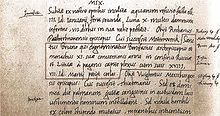
The first known record of the name of Lithuania (Lithuanian: Lietuva) is in a 9 March 1009 story of Saint Bruno in the Quedlinburg Chronicle.[23] The Chronicle recorded a Latinized form of the name Lietuva: Litua[24] (pronounced ). Due to lack of reliable evidence, the true meaning of the name is unknown and scholars still debate it. There are a few plausible versions.[25]
Since Lietuva has a suffix (-uva), there should be a corresponding original word with no suffix.[25] A likely candidate is Lietā. Because many Baltic ethnonyms originated from hydronyms, linguists have searched for its origin among local hydronyms. Usually, such names evolved through the following process: hydronym → toponym → ethnonym.[26] Lietava, a small river not far from Kernavė, the core area of the early Lithuanian state and a possible first capital of the eventual Grand Duchy of Lithuania, is usually credited as the source of the name.[26] However, the river is very small and some find it improbable that such a small and local object could have lent its name to an entire nation. On the other hand, such naming is not unprecedented in world history.[27]
Artūras Dubonis proposed another hypothesis,[28] that Lietuva relates to the word leičiai (plural of leitis). From the middle of the 13th century, leičiai were a distinct warrior social group of the Lithuanian society subordinate to the Lithuanian ruler or the state itself. The word leičiai is used in 14–16th century historical sources as an ethnonym for Lithuanians (but not Samogitians) and is still used, usually poetically or in historical contexts, in the Latvian language, which is closely related to Lithuanian.[29][30][31]
History
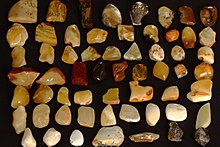
The history of Lithuania dates back to settlements founded about 10,000 years ago,[32][33] but the first written record of the name for the country dates back to 1009 AD.[34] Lithuanians, one of the Baltic peoples, later conquered neighboring lands and established the Grand Duchy of Lithuania in the 13th century (and also a short-lived Kingdom of Lithuania). The Grand Duchy was a successful and lasting warrior state. It remained fiercely independent and was one of the last areas of Europe to adopt Christianity (beginning in the 14th century). A formidable power, it became the largest state in Europe in the 15th century spread from the Baltic Sea to the Black Sea, through the conquest of large groups of East Slavs who resided in Ruthenia.[35]
In 1385, the Grand Duchy formed a dynastic union with Poland through the Union of Krewo. Later, the Union of Lublin (1569) created the Polish–Lithuanian Commonwealth. During the Second Northern War, the Grand Duchy sought protection under the Swedish Empire through the Union of Kėdainiai in 1655. However, it soon returned to being a part of the Polish–Lithuanian state, which persisted until 1795 when the last of the Partitions of Poland erased both independent Lithuania and Poland from the political map. After the dissolution, Lithuanians lived under the rule of the Russian Empire until the 20th century, although there were several major rebellions, especially in 1830–1831 and 1863.
On 16 February 1918, Lithuania was re-established as a democratic state. It remained independent until the onset of World War II, when it was occupied by the Soviet Union under the terms of the Molotov–Ribbentrop Pact. Following a brief occupation by Nazi Germany after the Nazis waged war on the Soviet Union, Lithuania was again absorbed into the Soviet Union for nearly 50 years.
1990–present
On 11 March 1990, the Supreme Council announced the restoration of Lithuania's independence. Lithuania became the first Soviet-occupied state to announce the restitution of independence. On 20 April 1990, the Soviets imposed an economic blockade by ceasing to deliver supplies of raw materials to Lithuania.[37] Not only domestic industry, but also the population started feeling the lack of fuel, essential goods, and even hot water. Although the blockade lasted for 74 days, Lithuania did not renounce the declaration of independence.
Gradually, economic relations were restored. However, tensions peaked again in January 1991. Attempts were made to carry out a coup using the Soviet Armed Forces, the Internal Army of the Ministry of Internal Affairs and the USSR Committee for State Security (KGB). Because of the poor economic situation in Lithuania, the forces in Moscow thought the coup d'état would receive strong public support.[38] People flooded to Vilnius to defend the Supreme Council of the Republic of Lithuania and independence. The coup ended with a few casualties and material loss. The Soviet Army killed 14 people and injured hundreds. A large part of the Lithuanian population participated in the January Events.[39][40] On 31 July 1991, Soviet paramilitaries killed 7 Lithuanian border guards on the Belarusian border in what became known as the Medininkai Massacre.[41] On 17 September 1991, Lithuania was admitted to the United Nations.
On 25 October 1992, citizens voted in a referendum to adopt the current constitution. On 14 February 1993, during the direct general elections, Algirdas Brazauskas became the first president after the restoration of independence. On 31 August 1993 the last units of the former Soviet Army left Lithuania.[42]
On 31 May 2001, Lithuania joined the World Trade Organization (WTO).[43] Since March 2004, Lithuania has been part of NATO.[44] On 1 May 2004, it became a full member of the European Union,[45] and a member of the Schengen Agreement in December 2007.[46] On 1 January 2015, Lithuania joined the eurozone and adopted the European Union's single currency.[47] On 4 July 2018, Lithuania officially joined the OECD.[48] Dalia Grybauskaitė was the first female President of Lithuania (2009–19) and the first to be re-elected for a second consecutive term.[49] On 24 February 2022, Lithuania declared a state of emergency in response to the 2022 Russian invasion of Ukraine.[50] Together with the eight other NATO member states, it invoked NATO Article 4 to hold consultations on security.[51] On 11–12 July 2023, the 2023 NATO summit was held in Vilnius.[52]
Geography

Lithuania is located in the Baltic region of Europe[a] and covers an area of 65,300 km2 (25,200 sq mi).[53] It lies between latitudes 53° and 57° N, and mostly between longitudes 21° and 27° E (part of the Curonian Spit lies west of 21°). It has around 99 kilometres (61.5 mi) of sandy coastline, only about 38 kilometres (24 mi) of which face the open Baltic Sea, less than the other two Baltic states. The rest of the coast is sheltered by the Curonian sand peninsula. Lithuania's major warm-water port, Klaipėda, lies at the narrow mouth of the Curonian Lagoon (Lithuanian: Kuršių marios), a shallow lagoon extending south to Kaliningrad. The country's main and largest river, the Nemunas River, and some of its tributaries carry international shipping.
Lithuania lies at the edge of the North European Plain. Its landscape was smoothed by the glaciers of the last ice age, and is a combination of moderate lowlands and highlands. Its highest point is Aukštojas Hill at 294 metres (965 ft) in the eastern part of the country. The terrain features numerous lakes (Lake Vištytis, for example) and wetlands, and a mixed forest zone covers over 33% of the country. Drūkšiai is the largest, Tauragnas is the deepest and Asveja is the longest lake in Lithuania.
After a re-estimation of the boundaries of the continent of Europe in 1989, Jean-George Affholder, a scientist at the Institut Géographique National (French National Geographic Institute), determined that the geographic centre of Europe was in Lithuania, at 54°54′N 25°19′E / 54.900°N 25.317°E, 26 kilometres (16 mi) north of Lithuania's capital city of Vilnius.[54] Affholder accomplished this by calculating the centre of gravity of the geometrical figure of Europe.
Climate
Lithuania has a temperate climate with both maritime and continental influences. It is defined as humid continental (Dfb) under the Köppen climate classification (but is close to oceanic in a narrow coastal zone).
Average temperatures on the coast are −2.5 °C (27.5 °F) in January and 16 °C (61 °F) in July. In Vilnius the average temperatures are −6 °C (21 °F) in January and 17 °C (63 °F) in July. During the summer, 20 °C (68 °F) is common during the day while 14 °C (57 °F) is common at night; in the past, temperatures have reached as high as 30 or 35 °C (86 or 95 °F). Some winters can be very cold. −20 °C (−4 °F) occurs almost every winter. Winter extremes are −34 °C (−29 °F) in coastal areas and −43 °C (−45 °F) in the east of Lithuania.
The average annual precipitation is 800 mm (31.5 in) on the coast, 900 mm (35.4 in) in the Samogitia highlands and 600 mm (23.6 in) in the eastern part of the country. Snow occurs every year, it can snow from October to April. In some years sleet can fall in September or May. The growing season lasts 202 days in the western part of the country and 169 days in the eastern part. Severe storms are rare in the eastern part of Lithuania but common in the coastal areas.
The longest records of measured temperature in the Baltic area cover about 250 years. The data show warm periods during the latter half of the 18th century, and that the 19th century was a relatively cool period. An early 20th-century warming culminated in the 1930s, followed by a smaller cooling that lasted until the 1960s. A warming trend has persisted since then.[55]
Lithuania experienced a drought in 2002, causing forest and peat bog fires.[56]
Environment
After the restoration of Lithuania's independence in 1990, the Aplinkos apsaugos įstatymas (Environmental Protection Act) was adopted already in 1992. The law provided the foundations for regulating social relations in the field of environmental protection, established the basic rights and obligations of legal and natural persons in preserving the biodiversity inherent in Lithuania, ecological systems and the landscape.[58] Lithuania agreed to cut carbon emissions by at least 20% of 1990 levels by 2020 and by at least 40% by 2030, together with all European Union members. Also, by 2020 at least 20% (27% by 2030) of the country's total energy consumption should be from the renewable energy sources.[59] In 2016, Lithuania introduced especially effective container deposit legislation, which resulted in collecting 92% of all packagings in 2017.[60]
Lithuania does not have high mountains and its landscape is dominated by blooming meadows, dense forests and fertile fields of cereals. However, it stands out by the abundance of hillforts, which previously had castles where the ancient Lithuanians burned altars for pagan gods.[61] Lithuania is a particularly watered region with more than 3,000 lakes, mostly in the northeast. The country is also drained by numerous rivers, most notably the longest Nemunas.[61] Lithuania is home to two terrestrial ecoregions: Central European mixed forests and Sarmatic mixed forests.[62]
Forest has long been one of the most important natural resources in Lithuania. Forests occupy one-third of the country's territory and timber-related industrial production accounts for almost 11% of industrial production in the country.[63] Lithuania has five national parks,[64] 30 regional parks,[65] 402 nature reserves,[66] 668 state-protected natural heritage objects.[67]
In 2018 Lithuania was ranked fifth, second to Sweden (first 3 places were not granted) in the Climate Change Performance Index (CCPI).[68] It had a 2019 Forest Landscape Integrity Index mean score of 1.62/10, ranking it 162nd globally out of 172 countries.[69]
Biodiversity

Lithuanian ecosystems include natural and semi-natural (forests, bogs, wetlands and meadows), and anthropogenic (agrarian and urban) ecosystems. Among natural ecosystems, forests are particularly important to Lithuania, covering 33% of the country's territory. Wetlands (raised bogs, fens, transitional mires, etc.) cover 7.9% of the country, with 70% of wetlands having been lost due to drainage and peat extraction between 1960 and 1980. Changes in wetland plant communities resulted in the replacement of moss and grass communities by trees and shrubs, and fens not directly affected by land reclamation have become drier as a result of a drop in the water table. There are 29,000 rivers with a total length of 64,000 km in Lithuania, the Nemunas River basin occupying 74% of the territory of the country. Due to the construction of dams, approximately 70% of spawning sites of potential catadromous fish species have disappeared. In some cases, river and lake ecosystems continue to be impacted by anthropogenic eutrophication.[72]
Agricultural land comprises 54% of Lithuania's territory (roughly 70% of that is arable land and 30% meadows and pastures), approximately 400,000 ha of agricultural land is not farmed, and acts as an ecological niche for weeds and invasive plant species. Habitat deterioration is occurring in regions with very productive and expensive lands as crop areas are expanded. Currently, 18.9% of all plant species, including 1.87% of all known fungi species and 31% of all known species of lichens, are listed in the Lithuanian Red Data Book. The list also contains 8% of all fish species.[72]
The wildlife populations have rebounded as the hunting became more restricted and urbanization allowed replanting forests (forests already tripled in size since their lows). Currently, Lithuania has approximately 250,000 larger wild animals or 5 per each square kilometre. The most prolific large wild animal in every part of Lithuania is the roe deer, with 120,000 of them. They are followed by boars (55,000). Other ungulates are the deer (~22,000), fallow-deer (~21,000) and the largest one: moose (~7,000). Among the Lithuanian predators, foxes are the most common (~27,000). Wolves are, however, more ingrained into the mythology as there are just 800 in Lithuania. Even rarer are the lynxes (~200). The large animals mentioned above exclude the rabbit, ~200,000 of which may live in the Lithuanian forests.[73]
Government and politics

Government
Since Lithuania declared the restoration of its independence on 11 March 1990, it has maintained strong democratic traditions. It held its first independent general elections on 25 October 1992, in which 56.75% of voters supported the new constitution.[74] There were intense debates concerning the constitution, particularly the role of the president. A separate referendum was held on 23 May 1992 to gauge public opinion on the matter, and 41% of voters supported the restoration of the President of Lithuania.[74] Through compromise, a semi-presidential system was agreed on.[4]
The Lithuanian head of state is the president, directly elected for a five-year term and serving a maximum of two terms. The president oversees foreign affairs and national security, and is the commander-in-chief of the military.[75] The president also appoints the prime minister and, on the latter's nomination, the rest of the cabinet, as well as a number of other top civil servants and the judges for all courts except the Constitutional Court.[75] The current Lithuanian head of state, Gitanas Nausėda was elected on 26 May 2019 by unanimously winning in all municipalities of Lithuania on the second election tour.[76]
The judges of the Constitutional Court (Konstitucinis Teismas) serve nine-year terms. The court is renewed by a third every three years. The judges are appointed by the Seimas, on the nomination of the President, Chairman of the Seimas, and the Chairman of the Supreme Court,. The unicameral Lithuanian parliament, the Seimas, has 141 members who are elected to four-year terms. 71 of the members of its members are elected in single-member constituencies, and the others in a nationwide vote by proportional representation. A party must receive at least 5% of the national vote to be eligible for any of the 70 national seats in the Seimas.[77]
Political parties and elections
Lithuania was one of the first countries in the world to grant women a right to vote in the elections. Lithuanian women were allowed to vote by the 1918 Constitution of Lithuania and used their newly granted right for the first time in 1919. By doing so, Lithuania allowed it earlier than such democratic countries as the United States (1920), France (1945), Greece (1952), Switzerland (1971).[78]
Lithuania exhibits a fragmented multi-party system,[79] with a number of small parties in which coalition governments are common. Ordinary elections to the Seimas take place on the second Sunday of October every four years.[77] To be eligible for election, candidates must be at least 25 years old on the election day, not under allegiance to a foreign state and permanently reside in Lithuania. Persons serving or due to serve a sentence imposed by the court 65 days before the election are not eligible. Also, judges, citizens performing military service, and servicemen of professional military service and officials of statutory institutions and establishments may not stand for election.[80] Homeland Union – Lithuanian Christian Democrats won the 2020 Lithuanian parliamentary elections and gained 50 of 141 seats in the parliament.[81] In October 2020, the prime ministerial candidate of Homeland Union-Lithuanian Christian Democrats (TS-LKD) Ingrida Šimonytė formed a centre-right coalition with two liberal parties.[82]

The President of Lithuania is the head of state of the country, elected to a five-year term in a majority vote. Elections take place on the last Sunday no more than two months before the end of current presidential term.[83] To be eligible for election, candidates must be at least 40 years old on the election day and reside in Lithuania for at least three years, in addition to satisfying the eligibility criteria for a member of the parliament. Same President may serve for not more than two terms.[84] Gitanas Nausėda has won the most recent election as an independent candidate in 2019.[76]
Each municipality in Lithuania is governed by a municipal council and a mayor, who is a member of the municipal council. The number of members, elected on a four-year term, in each municipal council depends on the size of the municipality and varies from 15 (in municipalities with fewer than 5,000 residents) to 51 (in municipalities with more than 500,000 residents). 1,524 municipal council members were elected in 2015.[85] Members of the council, with the exception of the mayor, are elected using proportional representation. Starting with 2015, the mayor is elected directly by the majority of residents of the municipality.[86] Social Democratic Party of Lithuania won most of the positions in the 2015 elections (372 municipal councils seats and 16 mayors).[87]
As of 2019, the number of seats in the European Parliament allocated to Lithuania was 11.[88] Ordinary elections take place on a Sunday on the same day as in other EU countries. The vote is open to all citizens of Lithuania, as well as citizens of other EU countries that permanently reside in Lithuania, who are at least 18 years old on the election day. To be eligible for election, candidates must be at least 21 years old on the election day, a citizen of Lithuania or a citizen of another EU country permanently residing in Lithuania. Candidates are not allowed to stand for election in more than one country. Persons serving or due to serve a sentence imposed by the court 65 days before the election are not eligible. Also, judges, citizens performing military service, and servicemen of professional military service and officials of statutory institutions and establishments may not stand for election.[89] Six political parties and one committee representatives gained seats in the 2019 elections.[90]
Law and law enforcement
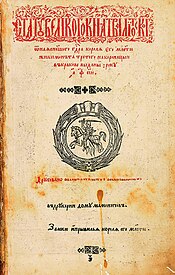
The first attempt to codify the Lithuanian laws was in 1468 when the Casimir's Code was compiled and adopted by Grand Duke Casimir IV Jagiellon.[91] In the 16th century three editions of the Statutes of Lithuania were created with the First Statute being adopted in 1529, the Second Statute in 1566, and the Third Statute in 1588.[91] On 3 May 1791, the Europe's first and the world's second Constitution was adopted by the Great Sejm.[92] The Third Statute was partly in force in the territory of Lithuania even until 1840, despite the Third Partition of the Polish–Lithuanian Commonwealth in 1795.[91]
In 1934–1935, Lithuania held the first mass trial of the Nazis in Europe, the convicted were sentenced to imprisonment in a heavy labor prison and capital punishments.[93]
After regaining of independence in 1990, the largely modified Soviet legal codes were in force for about a decade. The current Constitution of Lithuania was adopted on 25 October 1992.[94] In 2001, the Civil Code of Lithuania was passed in Seimas. It was succeeded by the Criminal Code and Criminal Procedure Code in 2003. The approach to the criminal law is inquisitorial, as opposed to adversarial; it is generally characterised by an insistence on formality and rationalisation, as opposed to practicality and informality. Normative legal act enters into force on the next day after its publication in the Teisės aktų registras, unless it has a later entry into force date.[95]
The European Union law is an integral part of the Lithuanian legal system since 1 May 2004.[96]
Lithuania, after breaking away from the Soviet Union, had a difficult crime situation, however, the Lithuanian law enforcement agencies fought crime over the years, making Lithuania a reasonably safe country.[97] Crime in Lithuania has been declining rapidly.[98] Law enforcement in Lithuania is primarily the responsibility of local Lietuvos policija (Lithuanian Police) commissariats. They are supplemented by the Lietuvos policijos antiteroristinių operacijų rinktinė Aras (Anti-Terrorist Operations Team of the Lithuanian Police Aras), Lietuvos kriminalinės policijos biuras (Lithuanian Criminal Police Bureau), Lietuvos policijos kriminalistinių tyrimų centras (Lithuanian Police Forensic Research Center) and Lietuvos kelių policijos tarnyba (Lithuanian Road Police Service).[99]
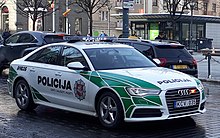
In 2017, there were 63,846 crimes registered in Lithuania. Of these, thefts comprised a large part with 19,630 cases (13.2% less than in 2016). While 2,835 crimes were serious and very serious (crimes that may lead to more than six years imprisonment), which is 14.5% less than in 2016. In total, 129 homicides or attempted homicide occurred (19.9% less than in 2016), while serious bodily harm was registered 178 times (17.6% less than in 2016). Another problematic crime contraband cases also decreased by 27.2% from 2016 numbers. Meanwhile, crimes in electronic data and information technology security fields noticeably increased by 26.6%.[100] In the 2013 Special Eurobarometer, 29% of Lithuanians said that corruption affects their daily lives (EU average 26%). Moreover, 95% of Lithuanians regarded corruption as widespread in their country (EU average 76%), and 88% agreed that bribery and the use of connections is often the easiest way of obtaining certain public services (EU average 73%).[101] Though, according to local branch of Transparency International, corruption levels have been decreasing over the past decade.[102]
Capital punishment in Lithuania was suspended in 1996 and eliminated in 1998.[103] Lithuania has the highest number of prison inmates in the EU. According to scientist Gintautas Sakalauskas, this is not because of a high criminality rate in the country, but due to Lithuania's high repression level and the lack of trust of the convicted, who are frequently sentenced to imprisonment.[104]
Administrative divisions

The current system of administrative division was established in 1994 and modified in 2000 to meet the requirements of the European Union. The country's 10 counties (Lithuanian: singular – apskritis, plural – apskritys) are subdivided into 60 municipalities (Lithuanian: singular – savivaldybė, plural – savivaldybės), and further divided into 500 elderships (Lithuanian: singular – seniūnija, plural – seniūnijos).
Municipalities have been the most important unit of administration in Lithuania since the system of county governorship (apskrities viršininkas) was dissolved in 2010.[105] Some municipalities are historically called "district municipalities" (often shortened to "district"), while others are called "city municipalities" (sometimes shortened to "city"). Each has its own elected government. The election of municipality councils originally occurred every three years, but now takes place every four years. The council appoints elders to govern the elderships. Mayors have been directly elected since 2015; prior to that, they were appointed by the council.[106]
Elderships, numbering over 500, are the smallest administrative units and do not play a role in national politics. They provide necessary local public services—for example, registering births and deaths in rural areas. They are most active in the social sector, identifying needy individuals or families and organizing and distributing welfare and other forms of relief.[107] Some citizens feel that elderships have no real power and receive too little attention, and that they could otherwise become a source of local initiative for addressing rural problems.[108]




